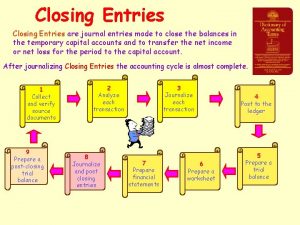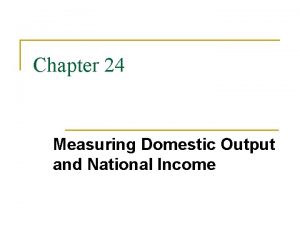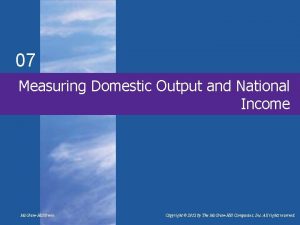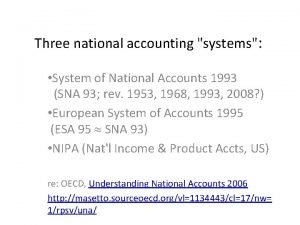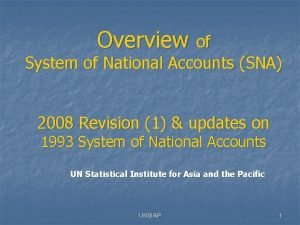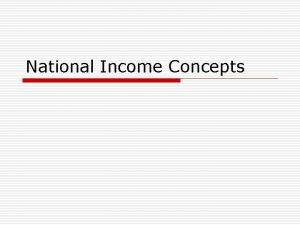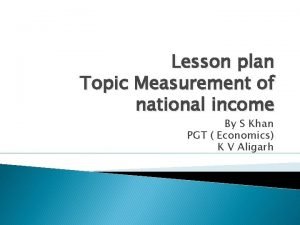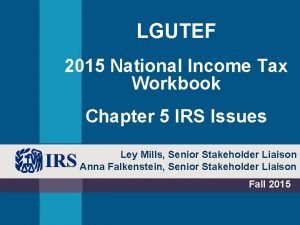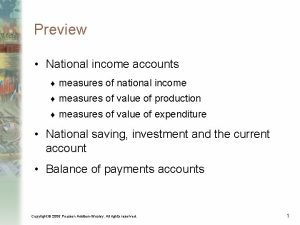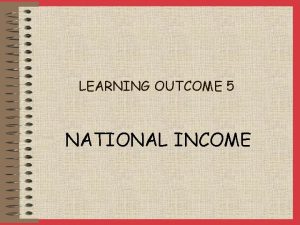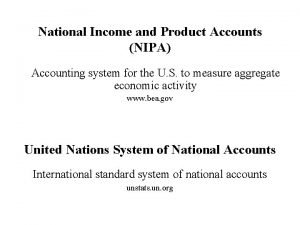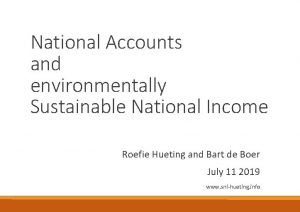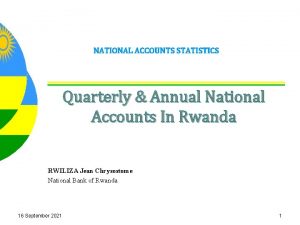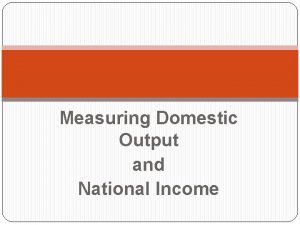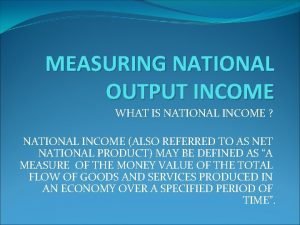INFO 4470ILRLE 4470 National Income and Product Accounts
























- Slides: 24

INFO 4470/ILRLE 4470 National Income and Product Accounts: Business Cycles John M. Abowd and Lars Vilhuber February 23, 2011 Thanks to Brent Moulton, BEA

What are the NIPAs? • The National Income and Product Accounts (NIPAs) are a set of economic accounts that track economic flows within the U. S. economy. • Two key NIPA measures are: – Gross domestic product (GDP): Measures the total value of goods and services produced within the U. S. in a period. – Gross domestic income (GDI): Measures the incomes earned and the costs incurred in producing those goods and services. 2/23/2011 Thanks to Brent Moulton, BEA

The Circular Flow Income Labor Businesses Households Goods and services Expenditures 3 2/23/2011 Thanks to Brent Moulton, BEA

NIPA Seven Section Summary 1. Domestic Income and Product Account – Private Enterprise Income Account 2. 3. 4. 5. 6. 7. Personal Income and Outlay Account Government Current Expenditures and Receipts Foreign Transactions Savings and Investment Income and Employment by Industry Supplemental Tables 2/23/2011 4 Thanks to Brent Moulton, BEA

GDP as Value-added • Value-added is measured as: – Output less intermediate consumption • Example: Wheat to flour to bread. • GDP is value of bread. – Equals sum of value added of farmer, miller, and baker. • GDP: the sum of industry value added • Also equals sum of final expenditures • Also equals sum of income earned in production 2/23/2011 5 Thanks to Brent Moulton, BEA

Section 1: Domestic Income and Product Compensation of employees, paid Personal consumption expenditures Taxes on production and imports Gross private domestic investment Less: Subsidies Net exports of goods and services Net operating surplus Government consumption expenditures and gross investment Consumption of fixed capital Gross Domestic Income 6 2/23/2011 Gross Domestic Product Thanks to Brent Moulton, BEA

Expenditure components of GDP (2005) GDP = C + I + G + X - M Consumption 70. 0% + 7 2/23/2011 Investment Government Exports Imports 16. 9% 18. 9% 10. 4% 16. 2% + + Thanks to Brent Moulton, BEA - = GDP

Income components of GDP (2005) Compensation 57. 1% Net operating surplus 23. 2% TOPI less subsidies + 8 2/23/2011 6. 8% Consumption of fixed capital 12. 6% + + Thanks to Brent Moulton, BEA Statistical discrepancy + 0. 3% = GDP

Section 1: Domestic Income and Product Compensation of employees, paid Taxes on production and imports Less: Subsidies Net operating surplus Consumption of fixed capital Gross domestic income Personal consumption expenditures Gross private domestic investment Net exports of goods and services Government consumption expenditures and gross investment Statistical discrepancy Gross Domestic Product 9 2/23/2011 Gross Domestic Product Thanks to Brent Moulton, BEA

Section 1 (16): Private Enterprise Income • Provides information on the sources and uses of the income of private enterprises. • Includes current-production corporate profits and proprietors’ income. Sources and Uses of Private Enterprise Income 10 2/23/2011 Thanks to Brent Moulton, BEA

Section 2: Personal Income and Outlays • Provides information on the sources and uses of income received by persons. • Includes personal income and personal saving. • Can derive disposable personal income and personal saving rate. Personal Income and Its Disposition 11 2/23/2011 Thanks to Brent Moulton, BEA

Section 3: Government Receipts and Expenditures • Provides information on the transactions of the federal government and state and local governments. • Includes social benefits and government saving. Government Current Receipts and Expenditures 12 2/23/2011 Thanks to Brent Moulton, BEA

Section 4: Foreign Transactions • Provides information on trade in goods in services with the rest of the world. • Includes imports, exports, and the balance on the current account. Foreign Transactions in the NIPA 13 2/23/2011 Thanks to Brent Moulton, BEA

Section 5: Savings and Investment • Provides information on saving and investment for the U. S. economy. • Key measures: Gross saving, which is net saving plus the consumption of fixed capital, and net saving, which is a measure of saving that is available for adding to the nation’s net stock of fixed assets. Saving and Investment by Sector 14 2/23/2011 Thanks to Brent Moulton, BEA

Section 6: Income and Employment by Industry • Provides industry detail on national income, compensation and employment 2/23/2011 Thanks to Brent Moulton, BEA 15

Section 7: Supplemental Tables • Provides detail on selected sectors of the economy • Provides detail on imputations • Provides detail on capital accounts 2/23/2011 Thanks to Brent Moulton, BEA 16

Features of national accounts • Inflation-adjusted (“real” GDP) • Quarterly frequency • Seasonally adjusted • Annualized 17 2/23/2011 Thanks to Brent Moulton, BEA

Estimation cycle • “Advance” estimates are released about 31/2 weeks after a calendar quarter concludes. • “Preliminary” and “final” estimates are released 30 and 60 days after the advance. 18 2/23/2011 Thanks to Brent Moulton, BEA

Annual revisions and benchmarking • “Annual revisions” are released in July of noncomprehensive revision years. • “Comprehensive revisions” occur about every 4 -5 years. 19 2/23/2011 Thanks to Brent Moulton, BEA

GDP by Sector, 2005 Households and institutions 11. 5% Business 77. 3% Government 11. 2% 20 2/23/2011 Thanks to Brent Moulton, BEA

Featured measures • Real GDP growth, as indicated by the percent change in the chain-type quantity index. • Contributions to real GDP growth reflect the role that individual components of GDP play in producing the growth in GDP. • Gross domestic purchases price index (and personal consumption expenditures price index)—inflation measures that reflect prices of goods and services purchased by U. S. residents. 21 2/23/2011 Thanks to Brent Moulton, BEA

Other important GDP-related measures • Current-dollar GDP represents the value of production at a point in time. • GDP percentage shares provide a measure of the size and importance of a component. 22 2/23/2011 Thanks to Brent Moulton, BEA

NBER Recessions Real GDP 23 2/23/2011 Thanks to Brent Moulton, BEA

National Income and Product Account Data • Accounts: http: //www. bea. gov/national/index. htm • NBER Business Cycles: http: //www. nber. org/cycles/main. html 2/23/2011 Thanks to Brent Moulton, BEA 24
 National income and product accounts
National income and product accounts Cs 4470
Cs 4470 Control company 4470
Control company 4470 Cs 4470
Cs 4470 Per capita income formula
Per capita income formula Gnp gdp meaning
Gnp gdp meaning Closing entries accounting
Closing entries accounting Accounting income vs taxable income
Accounting income vs taxable income Income from operations formula
Income from operations formula Chapter 16 accounting for income taxes
Chapter 16 accounting for income taxes Measuring domestic output and national income
Measuring domestic output and national income Outputs
Outputs Measuring domestic output and national income
Measuring domestic output and national income Measuring domestic output and national income
Measuring domestic output and national income York national accounts
York national accounts System of national accounting
System of national accounting System of national accounts (sna)
System of national accounts (sna) Advisory expert group on national accounts
Advisory expert group on national accounts Tatlong paraan ng national income accounting
Tatlong paraan ng national income accounting National income formula
National income formula Lesson plan on national income
Lesson plan on national income National income formula
National income formula Lgutef
Lgutef Linear algebra
Linear algebra Final expenditure approach
Final expenditure approach






